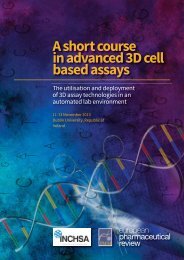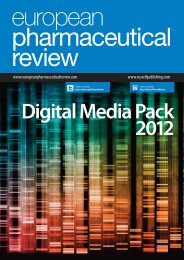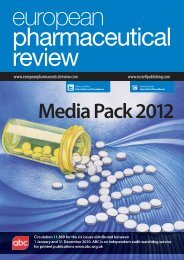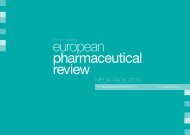Real time PCR - European Pharmaceutical Review
Real time PCR - European Pharmaceutical Review
Real time PCR - European Pharmaceutical Review
You also want an ePaper? Increase the reach of your titles
YUMPU automatically turns print PDFs into web optimized ePapers that Google loves.
SUBSCRIBE<br />
ISSUE<br />
2009 LAB AUTOMATION<br />
Article 1:<br />
Lab Automation series<br />
Dr Sheraz Gul, Vice President and Head of Biology, <strong>European</strong> ScreeningPort<br />
Welcome to the first Drug Discovery Developments section of <strong>European</strong> <strong>Pharmaceutical</strong> <strong>Review</strong><br />
Digital. The purpose of the updates is to bring to the attention of the reader advances that have been<br />
made in the life science and pre-clinical Drug Discovery research efforts. Case studies will be<br />
discussed in relation to topics that offer the potential to increase the efficiency and likelihood of<br />
success in Drug Discovery. In this edition, advances in the design and development of automation<br />
solutions for High Throughput Screening (HTS) will be discussed.<br />
The use of small molecule<br />
libraries in HTS campaigns to<br />
identify compounds that are<br />
capable of modulating the activity of<br />
the target under investigation has for<br />
the previous decade been widely<br />
exploited by the pharmaceutical<br />
industry. More recently, screening has<br />
also been adopted by others such as<br />
academic research organisations.<br />
A key requirement for executing HTS<br />
campaigns is access to a compound<br />
library. There are significant<br />
differences in the sizes of the<br />
compound libraries that the<br />
pharmaceutical industry and<br />
academic research organisations<br />
possess or have access to and this<br />
trend is likely to continue for reasons<br />
such as the significant costs<br />
associated with the acquisition of the<br />
libraries, the requirement to purchase<br />
and maintain an appropriate and<br />
reliable hardware and IT<br />
infrastructure to manage the libraries,<br />
the need to perform appropriate<br />
quality control experiments on the<br />
compounds to monitor their integrity<br />
and replacing deteriorated or<br />
depleted stocks. These extra<br />
functionalities require significant<br />
financial investment which usually<br />
can only be fully funded by the<br />
pharmaceutical industry. As a result<br />
of the variation in the sizes of<br />
compound libraries, researchers<br />
require varying degrees of automated<br />
solutions. In those cases where a few<br />
‘‘There are significant<br />
differences in the sizes of the<br />
compound libraries that the<br />
pharmaceutical industry and<br />
academic research<br />
organisations possess or have<br />
access to and this trend is<br />
likely to continue for reasons<br />
such as the significant costs<br />
associated with the<br />
acquisition of the libraries’’<br />
relatively simple manual tasks are<br />
carried out, off the shelf solutions are<br />
usually sufficient. At the other<br />
extreme, there may be a need to cater<br />
for throughputs in excess of 100,000<br />
tests per day. In such cases, suppliers<br />
are often required to provide custom<br />
made solutions and they can be (i) in<br />
the form of an integrated package<br />
from a variety of suppliers or (ii) an<br />
entire solution provided by a sole<br />
supplier. The solutions for those<br />
requiring complex high throughput<br />
capabilities inevitably end up being<br />
financially costly not just in terms of<br />
their initial purchase price, but also in<br />
terms of preventative maintenance<br />
and service contracts.<br />
High Content Screening<br />
In the pharmaceutical industry, High<br />
Content Screening (HCS) is becoming<br />
firmly established and increases the<br />
repertoire of technologies that are<br />
envisaged to aid the reduction in the<br />
high attrition rates in Drug Discovery.<br />
All too often, the identification of<br />
compounds that exhibit the ability to<br />
modulate the activity of a<br />
therapeutically relevant target in<br />
isolation fail to translate their<br />
behavior when evaluated in a cellular<br />
context. Compounds identified from<br />
screening activities against libraries<br />
carried out in a HCS setting may be<br />
better starting points for drug<br />
discovery efforts.<br />
Whereas up until recently HCS<br />
was used after the execution of an<br />
GO TO CONTENTS PAGE 25






